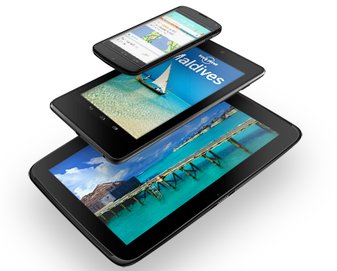Since then, the music landscape has undergone a sea change. But discovering music in a similar way is still possible via the latest and fast-evolving trend in digital music: streaming.
Perhaps the best-known streaming music app is Spotify. This app lets you listen to any of your favorite tracks at will, and it is also a digital radio that streams new music. Its interface is simple, bordering on spartan: it has a main screen where you control the music you are hearing, and a menu screen that lets you access different sections of the app and adjust settings.
To listen to a track you simply choose “Search” and type the artist’s name or a word from the track’s title. Spotify then lists the results by artist, album and song title. A more interesting way to use the app, however, is to select the “Discover” option. This reveals a long graphics-heavy list containing all sorts of different music.
Some of this will be familiar (right now, my app is telling me “You’ve been listening to a lot of Daft Punk lately” and recommends one of their albums), some of it will be new. These tracks include new releases, and music that is popular or is being listened to by nearby Spotify users.
There’s also a “Radio” option that has “stations” that stream either a particular band’s music, or genres of your choice, from Alternative to Trance. The app has straightforward controls and will show you album art and even band biographies.
Spotify has changed how I listen to music. But while the app is free on iOS, Android and Windows Phone 8, using it may cost you. In the United States, you can listen to the app’s radio stations free, but to listen to specific tracks you’ll have to subscribe for $10 a month.
For a different experience, you might try Rhapsody (which in some places overseas goes under the Napster brand). As in Spotify, you can search for music you want to hear, or discover new music through a few different routes. For example, the Browse section breaks music into genres; inside each genre’s page you can choose from new releases or popular tracks.
Alternatively, you can find new music through Rhapsody’s home page, which offers access to featured music, new releases and popular tracks. There are also Playlists, which are a little like Spotify’s stations. These lists have a regularly updated selection of music that will stream to you. There are extras like album reviews, so you can learn more about the artist you’re listening to.
Rhapsody’s interface is graphically richer and feels easier to navigate than Spotify’s, thanks to features like its ever-present icon bar. Bu you may find that Rhapsody’s graphics and many settings get in the way of your listening experience. It’s free to download on iOS, Android and Windows Phone 8, but you’ll have to pay $10 a month for unlimited music streaming.
Last.fm was one of the first players that streamed music over the Internet, and now it’s available as an app. Instead of concentrating on giving you access to new music, a bit like traditional radio, Last.fm tries to recommend new music based on the tracks you already listen to. In fact, it monitors music that you play through your mobile device, and keeps a list of it in your profile — a trick it calls “scrobbling.”
The scrobbled list can be shared online and is used to recommend lists of music similar to the kind you already like. The data comes from other Last.fm users’ lists. Last.fm is powerful and entertaining, but its interface is more basic than its peers’ and it doesn’t quite have the same range of music discovery options. And, though the app is free on iOS, Android and Windows Phone 8, to listen to the recommended lists you have to pay $3 a month.
Finally, there’s SoundCloud, a free app for iOS and Android that offers a different kind of streaming music. Where Spotify is like having radio on your phone, SoundCloud is more about hearing new music shared by indie artists via a social network. It has a wonderfully simple interface and it’s fun to use — you can upload your own music and share that too. Just don’t expect to find mainstream rock bands on this app.
Hopefully, you’ll find tons of new music to listen to via these apps, but remember there are other options. The Pandora app is well known and definitely worth trying. Apple is also poised to introduce iTunes Radio — a free service with advertisements. Streaming music is a fast-changing scene, so it’s worth keeping an eye out for special offers.
Quick Call
Telenav Scout, a successful GPS navigation app that’s done well on Android and iOS, has finally hit Windows Phone 8 devices. The core app is free, but advanced features like red light alerts will cost you $25 a year.

Article source: http://www.nytimes.com/2013/08/29/technology/personaltech/streaming-for-a-good-beat-thats-just-to-your-taste.html?partner=rss&emc=rss


